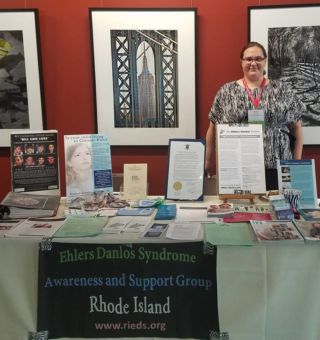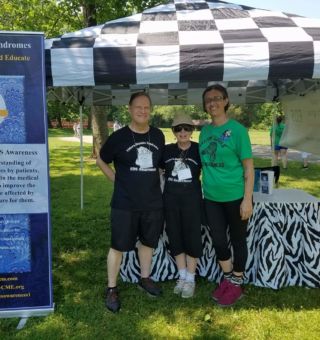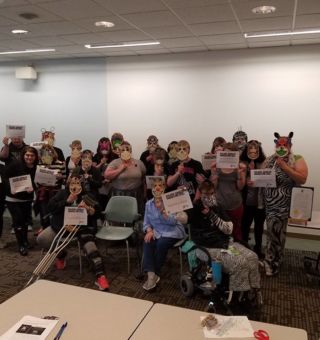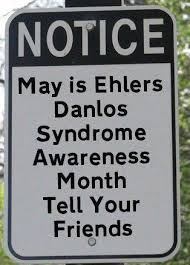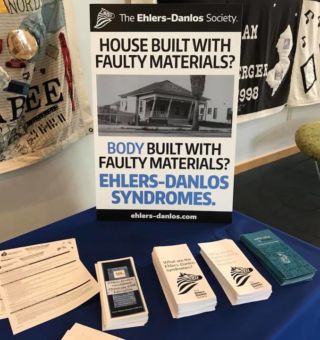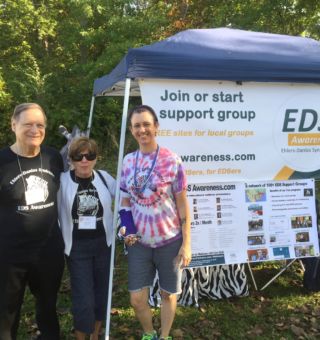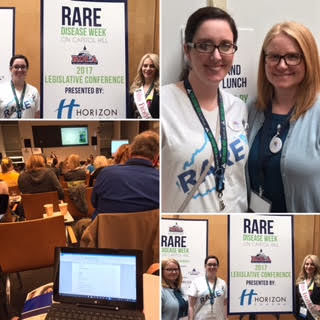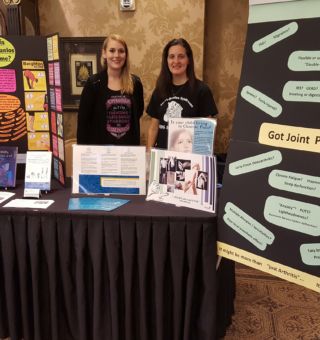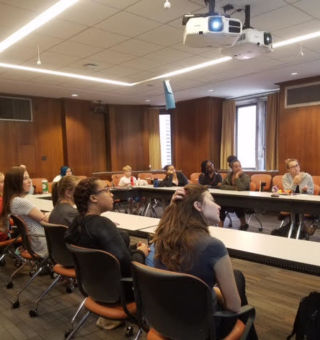The Chronic & Rare Coalition Articles
Local awareness activities, personal experiences and how EDS affects daily living.
PERIODIC PARALYSIS AWARENESS
Familial Periodic Paralysis is a muscle channelopathy which can accompany Ehlers-Danlos Syndrome. For more information on this rare disease, please visit the Periodic Paralysis Association site and feel free to reach out to one of the board members: https://periodicparalysis.org/about-the-association/
PURSUING A DIAGNOSIS OF PERIODIC PARALYSIS
Primary Periodic Paralysis: Advice for Clinicians & Future Directions
Tori Rodriguez, MA, LPC in Neurology Advisor April 26, 2018
“In addition, this is not a misunderstanding as such, but there is anecdotally a very high incidence of the Ehlers-Danlos spectrum of disorders in people with PP, to the extent that patients with either disease should be asked about symptoms of the other. This has so far never been published. The coexistence of the 2 disorders obviously makes mobility and pain control more difficult for the patient.“
In part 1 of this 2-part series, retired hematologist-oncologist Annabelle Baughan described her difficult personal experience as a patient with a periodic paralysis (PP) disorder. This article, part 2, resumes just after she was finally diagnosed and, later in the article, includes input from Deborah Cavel-Gréant, the president of Periodic Paralysis International.
Dr Baughan: I have so-called “gene negative,” Andersen-Tawil Syndrome (ATS), Type 2; that is, no mutation has yet been found in the commonly examined areas of my KCNJ2 gene. This does not currently impinge on the quality of care I receive, but it significantly delayed my diagnosis and appropriate management. It does however mean that I cannot participate in any clinical trials in ATS, as the very few that exist require that patients have a defined KCNJ2 mutation. Up to 30% to 40% of patients with a PP disorder are so-called gene negative; that is, their mutation has not yet been characterized. But these patients, with identical phenotypes to “gene-positive” patients can and should have the diagnosis clinically confirmed and, in the state of current knowledge, should be treated in the same way.
Why is it so difficult to obtain treatment and advice before genetic results are available? The president of Periodic Paralysis International, Deborah Cavel-Gréant, sums it up perfectly: “It has frequently been our experience that physicians are unwilling to treat until a patient has a genetic identification. Since identification of genetic variants remains an ongoing process, this can leave patients without treatment for years. Before 1994, physicians relied on their clinical skills to diagnose patients, and a good clinical diagnosis is and should be entirely viable as a treatment platform.
My routine care is with annual review now, or as needed, with a local neurologist and cardiologist — and both are wise and supportive. My general practitioner continues to be superb — this is so crucial with rare life-long diseases — and does everything possible to facilitate my own medical overview of my increasingly complex set of disorders and medications. I made the decision not to risk taking a carbonic anhydrase inhibitor, as I had a severe allergic response to a sulfa drug as a child. I take eplerenone, prescribed to help reduce muscle edema and raise serum potassium level. I am careful with my diet, but I am lucky compared to most people with hypokalemic PP in that I do tolerate a reasonable level of carbohydrates and sodium — this tolerance can be seen in hypokalemic PP when part of ATS. But I am very sensitive to fasting — delayed or missing meals are marked triggers for palpitations and muscle weakness.
I take prophylactic potassium supplements, at least 100 MEq a day and often 200 MEq, in a mixture of both immediate-release and slow-release potassium. The dose is highly empiric, and depends on the frequency of severe palpitations and supraventricular tachycardia episodes. I frequently manage these episodes myself without going to the emergency department using high-dose immediate-release oral potassium, a beta-blocker, relaxation exercises, and Valsalva maneuvers. I also self-check my serum potassium levels, thanks to an open-ended request form from my family doctor and a very convenient system of walk-in commercial laboratories here in France, with results available on the internet within a few hours. As can be seen in patients with ATS, potassium supplementation is very helpful for my cardiac depolarization defect, but too much potassium can make my muscles weaker. It’s clinical decision-making, several times a day, but now completely routine for me.
I keep emergency supplies of effervescent potassium everywhere — in the car and in all handbags. I never leave the house without it nor without my little hand-held electrocardiogram (ECG) recorder. I can usually cope with supraventricular tachycardias myself but polymorphic ventricular ectopy on the trace would mean that I should hightail it to the emergency department. None of this is fun, but I can cope with it, particularly with the immense support and loving tolerance I am lucky enough to have from my partner. Loving friends remain very supportive, but not all of them — one loses friends when one has a chronic severe disorder. Most are unable to understand the concept of my completely unpredictable “good days” and “bad days,” which can be awkward socially. I need to cancel events at short notice too often. It is trying for one’s friends — and for me.
My physical, muscular, capacity is now about 25% of what it was 10 years ago. I do not tolerate any formal exercise now, as it routinely shifts so much potassium intracellularly that I run too high a risk for an acute dysrhythmia, but I try to walk at least 100 yards most days. I usually need a walking stick. Long days wandering around cities and shops and museums are now out of the question, but I can still enjoy trips out if I pace myself. Carrying anything heavy is difficult and worsens my muscle pain for a day or two. But rail and air travel have been transformed for the better by always using their services for people with disabilities — lovely young porters taking all the luggage, being seated on the train before anyone else, being sped in a wheelchair past passport control lines — it’s bliss!
It took me a couple of years to properly define the triggers for my attacks. Some triggers affect my muscles more than the heart, and vice versa. They are triggers common to many other patients with PP. Many drugs — including, from my experience, magnesium, benzodiazepines, corticosteroids, antihistamines, adrenaline in local anesthetics, and opiates. And with ATS, all drugs that prolong the QT interval are contraindicated. Being cold and damp, adrenergic stress, fasting, prolonged muscular tension, a large carbohydrate load, prolonged immobilization, and very low barometric pressure are additional triggers that I recognize and attempt to avoid. I also avoid fluorescent lighting whenever possible, wearing dark sunglasses when I can’t avoid it. I can also be triggered by red and yellow food colorings and monosodium glutamate. From a cardiac rhythm point of view, I also need to avoid caffeine in any form.
Living with ATS is finally pretty stable for me now, but things can still go wrong sometimes, either because I “overdo it” or because many healthcare staff will not listen to me or my partner. They often will not read a medical summary and the ATS management guidelines I carry with me always. I consider hospitals, particularly as an inpatient, to be very dangerous places for people with PP. Most of us with a PP disorder need to take so much care in our daily lives to optimize our health — take the right medication at the right dose and at the right time, avoid triggers, eat the right sort of food at the right time of day, exercise when needed, rest when needed, and so on. Once one is an inpatient, all that careful management is usually thrown out the window by the staff. My worst paralysis — and it was bad — in the last year was iatrogenic: during an elective admission for an unrelated disorder. The nursing and medical staff ignored all recommendations about keeping me warm, avoiding prolonged fasting, switching off fluorescent lighting, avoiding prolonged muscle immobilization, and other requirements. It was a sort of PP attack trigger cascade nightmare — unforgivable.
Many intelligent people seem not to be able to get their heads around that the attack triggers themselves may be very banal, but the consequence of ignoring them can be very significant, even fatal. It is entirely exhausting when ill in the hospital for whatever reason to constantly have to challenge and check things — drugs, meals, etc — to make sure they will not harm me. And because so very few people understand these rare PP disorders, I am rapidly assumed to just be fussy and anxious, which further disadvantages my medical care and adds to my adrenaline stress.
And finally, a footnote so to speak, a story of anatomic anomalies in ATS. My partner has teased me gently for years about my rather peculiar toes and little fingers. I thought they were rather distinguished! But one PP specialist I saw was so delighted by my — even subtle — syndactyly and clinodactyly, that his face lit up when I took my socks off (not a common reaction to my feet). I finally know why I have strange digits, but it did cheer me up that someone was actually interested at last in one of my clinical features.
This concludes Dr Baughan’s account of her personal experience with PP. She and Ms Cavel-Gréant jointly responded to the questions below.
Neurology Advisor:Based on your experience, what are your thoughts on the current state of treatment for PP?
Individual ideal prophylactic measures, treatment of acute attacks at home, and potassium treatment regimens are significantly hampered by the lack of an easy-to-use, insurance-funded, and accurate home-use finger prick blood potassium meter. There is a meter available for saliva testing, but it does not have US Food and Drug Administration approval. The ability to accurately measure one’s blood potassium level would help transform the lives of many patients with PP. One waits in hope for someone, somewhere to champion this and get it to market.
The need for potassium supplementation in hypokalemic PP appears to be highly individual. But it needs to be recognized that some patients require very high doses of prophylactic potassium, and doctors need to be reassured that high doses (even 200-300 MEq daily) are typically tolerated very well — just some overview and caution is needed in elderly patients and in anyone with abnormal renal function.
Available treatments for PP are at best only adequate. Very few patients are attack free, and even long-term treatment does not prevent disabling permanent muscle myopathy in all patients. However, without treatment, many patients would be completely disabled and run the risk of fatal attacks resulting from respiratory and cardiac failure and/or arrest.
The most important thing any physician needs to know when treating a patient with one of the periodic paralyses is that one size does not fit all, even between 2 members in the same family. Mother and child, or brother A and brother B, may need different medications and different doses. Therapies may need to be combined to achieve control over episodes — for example, for patients with hypokalemic PP, a potassium-sparing diuretic plus oral fast-acting potassium to take at the first symptom of an attack. Likewise, patients with hyperkalemic potassium paralysis and myotonia might begin with a potassium-sparing diuretic plus a low dose of a sodium channel blocking agent like paroxetine (20-40 mg once daily) or lacosamide (50 mg twice daily), which are used off label rather than using the cardiac drugs with their much greater side effects.
Undoubtedly, more clinical trials need to be carried out for PP. This is not easy because of the rarity, but it is doable. Many patients are disappointed that so much emphasis is given to molecular channel and genetic research in the PP disorders and so little to clinical trials and observational studies. Why are there so many publications about the minutiae of genetic mutations and muscle cell electrophysiology and so few about patients’ symptoms and their treatment?
Neurology Advisor:What are some of the misunderstandings that can cause problems for patients with PP, and what else should physicians know about these disorders?
The first and most common misunderstanding, and perhaps the most important one, is that potassium levels during attacks must be either lower or higher than laboratory norms — this is not true. Dr Ingrid Gamstorp, who described the hyperkalemic form of PP, campaigned vigorously for the rejection of the terms “hypokalemic” and “hyperkalemic,” as weakness in these disorders is not directly related to the serum potassium level but is actually related to the ratio between the intracellular and extracellular potassium. Many patients’ serum potassium levels never leave the laboratory normal range, especially those with hyperkalemic PP and patients who are past adolescence.
Attack triggers may be trivial — for example getting cold, missing a meal — but the consequences of ignoring them may be very serious. Healthcare staff must be repeatedly encouraged to understand this.
Publications classically say that respiratory muscles are not affected in PP. Many, many patients say otherwise. Hypoventilation, choking, even clinical respiratory distress, are well known, and respiratory failure is a well-recognized cause of death in a paralytic attack. There are also widespread sleep disturbances in PP, including a substantial number of patients who have been diagnosed with obstructive or central sleep apnea. This is rarely recognized by doctors. We would suggest that polysomnogram testing be carried out in every patient with a PP diagnosis.
Paralytic attacks can last from minutes to days. There is often something of a pattern in individual patients, and between the different PP disorders, but this is not set in stone and should never be used as a criterion to exclude a diagnosis. The speed of onset of paralysis attacks varies too. Some patients have even 30 minutes of warning, others, just seconds. This should be discussed with each patient to establish a system of safety for them. There is no typical distribution of the paralysis or paresis. It may be unilateral, or just an arm, for example. “Dense quadriplegia” is not a prerequisite for diagnosis.
The steady-state ECG among different patients with ATS is hugely variable, from literally thousands of ventricular ectopies daily, to a normal ECG. There is no definitive, diagnostic pattern. Some patients require internal defibrillators and/or pacemakers, while many others do not. Although all medications that prolong the QT interval are contraindicated in all patients with ATS, some patients do not have a prolonged QT interval, while in some it is intermittent, and in others it is a permanent feature.
In addition, this is not a misunderstanding as such, but there is anecdotally a very high incidence of the Ehlers-Danlos spectrum of disorders in people with PP, to the extent that patients with either disease should be asked about symptoms of the other. This has so far never been published. The coexistence of the 2 disorders obviously makes mobility and pain control more difficult for the patient.
Many patients with genetic PP report frequent and significant problems with many medications — multiple side effects, perhaps even more allergies than in others, but mostly reactions to very small doses of drugs, both therapeutically and adversely. It seems wise to start all people with PP on very small doses of any drug and then gradually increase the dose as tolerated.
The PP disorders are channelopathies of muscle fibers (and myocardium in Andersen-Tawil) and perhaps clinically in other tissues yet to be classified. PP is not a neurologic disease. Some patients wonder if they may be better served by being looked after by rare-disease physicians, or perhaps by metabolic specialists, rather than by neurologists. Perhaps a multispecialty medical team would be the ideal. But none of this is ever discussed openly. Perhaps we should discuss it.
There are a variety of congenital anatomic anomalies reported in ATS. However, very few patients display all of them, and the changes may be very subtle but should specifically be looked for when making the diagnosis.
Most doctors and nurses know nothing about the PP disorders. This is forgivable as they are rare disorders — particularly ATS — but some doctors like to say that they know all about PP when in fact they don’t. This is unforgivable and dangerous. Please admit forgivable ignorance and ask for advice from an expert. And ask for information from the patient — many people diagnosed with rare disorders know more about them than their doctors do and are often cognizant of the up-to-date medical literature.
The symptoms in the genetic PP disorders are intermittent. That is why they are called “periodic” — or [they would be better referred to as] “episodic.” Between acute attacks, the person, particularly a younger patient, is likely to be fit and well with no abnormal physical findings. This clearly makes diagnosis more challenging. Even during an attack, there may be no physical signs apart from the subjective and objective flaccid paralysis. It is reported that tendon reflexes may be diminished or absent during paralysis.
PP may be fatal. Over the 20-year history of the Periodic Paralysis International listserve, with a more or less stable membership at any one time of 250 clinically or genetically diagnosed members, we have lost over a dozen members directly to PP attacks, most in the prime of life — 5 within hours of surgery or during recovery. Perioperative care is a very risky time for patients with any of the Periodic Paralysis disorders. Dangers are especially with the use of anaesthetic agents, but many aspects of hospital care can provoke crises in PP patients. Periodic Paralysis International has published a literature search and practical guidelines for peri-operative care which can be found at www.hkpp.org
Muscle strength between attacks, which patients may rate as ”normal” and not recognize as weakness, is actually reduced from “healthy normal” by 15% to 17%. However, when you’ve never felt “healthy normal,” the reduction feels normal. Falls from weakness and subsequent broken bones are so common, we don’t even keep count.
Nearly 90% of patients report near-constant muscle pain, but half are told by their physicians that PP doesn’t hurt, and some have been initially denied a diagnosis because of muscle pain. Others continue to be denied appropriate analgesia — at worst, accused of drug-seeking behavior.
And the disease doesn’t go away at 40 — while attacks gradually become less precipitous, weakness settles in with age and becomes a constant companion, reducing strength and stamina with each passing year. This is the permanent muscle weakness that patients often fear. The percentage is high. Some patients’ muscles may atrophy, and some look perfectly normal, but they don’t work properly. Patients with PP need to begin receiving the same kind of aids and supportive services people with multiple sclerosis or other neuromuscular disorders get — for example, bracing to stabilize joints and prevent falls, power wheelchairs, and ramps.
References
- Baughan ASJ, Cavel-Greant D, Megalo J, Weber F. Anaesthesia and peri-operative care in the primary periodic paralysis disorders–part 1: A review of the literature. https://drive.google.com/file/d/0B-savOlQA6QCSFQwQUQ5RWhRWVE/view Accessed March 30, 2018.
- Baughan ASJ, Cavel-Greant D, Megalo J, Weber F. Anaesthesia and peri-operative care in the primary periodic paralysis disorders–part 2: Practical guidelines. https://drive.google.com/file/d/0B-savOlQA6QCOWdjYVBoTFJWMDA/view Accessed March 30, 2018.








